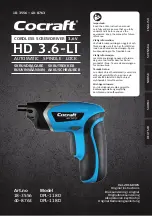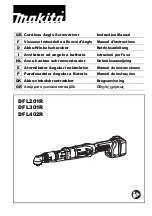
EN
G
LI
S
H
4
e)
When using power tools outdoors, use an extension lead that is suitable for
this purpose.
The use of an extension lead designed for outdoor use decreases
the risk of electric shocks.
f)
If for some reason you must use a power tool in a wet environment, always
connect it to the mains via an earth-fault circuit breaker such as an RCD
(residual current device).
Using an RCD significantly reduces the chances of you
receiving an electric shock.
Personal safety
a)
Pay attention to your actions and use common sense when using power
tools. Do not use power tools if you are tired or under the influence of drugs,
alcohol or medication.
One moment of inattention while using a power tool may
result in serious injury.
b)
Use protective equipment. Always wear safety glasses.
Using protective
clothing such as dust masks, non-slip safety shoes, helmets and ear defenders
when needed decreases the risk of injury.
c)
Avoid accidental starts. Make sure that the power switch is set to OFF
before plugging the machine into a wall socket.
Never carry a power tool with
your finger on the trigger and never connect the power tool to a wall socket when
the switch is set to ON, as it may result in injury.
d)
Remove all service tools/keys before switching the power tool on.
A service
tool left on any of the power tool’s rotating parts may result in injury.
e)
Do not overreach. Make sure you stand steady and well balanced at all times.
This will allow you to have more control in unexpected situations.
f)
Wear suitable attire. Do not wear loose-fitting clothing or jewellery. Keep hair,
clothes and gloves away from moving parts.
Loose-fitting clothes, jewellery or
long hair could potentially become caught in any moving parts.
g)
If equipment for dust extraction or collection is available, make sure that
it is connected and used properly.
Using technical aids may decrease dust
related hazards.
Proper use and maintenance of power tools
a)
Do not force the power tool. Use a power tool suitable for the work you are
about to perform.
The proper power tool will perform the task better and safer if
used at the correct feed rate.
b)
Never use the power tool if the power switch does not switch the tool on and
off properly.
All power tools that cannot be controlled by the power switch are
dangerous and must be repaired.
c)
Unplug the lead from the wall socket, before making any adjustments,
changing accessories or storing the power tool.
These precautions reduce
the risk of the power tool starting unexpectedly.





































